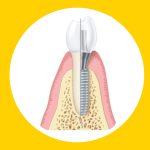Surface preparation plays a crucial role in the success of dental implants. Among the different surface modification techniques, sandblasting and acid etching have proven to be two of the most effective methods for improving the implant’s surface properties.
In this blog, we’ll explore how sandblasting and acid etching work, why they are critical to the success of dental implants, and the science behind their effectiveness in promoting bone growth and implant stability.
What is Surface Modification in Dental Implants?
Before we dive into the specifics of sandblasting and acid etching, it’s important to understand the role of surface modification in dental implants. The primary goal of surface modification is to enhance osseointegration, the process by which the bone bonds with the surface of the implant. A modified surface allows for better interaction with the surrounding bone tissue, accelerating healing and ensuring the long-term stability of the implant.
Surface roughness plays a pivotal role in this process. Research shows that a moderately rough surface promotes bone cell attachment, proliferation, and differentiation, all of which are essential for strong osseointegration. This is where sandblasting and acid etching come into play.
What is Sandblasting in Dental Implants?
Sandblasting, also known as large grit sandblasting, is a process where the implant surface is bombarded with tiny, high-pressure particles, usually made of titanium dioxide or aluminum oxide. These particles “blast” away material from the implant’s surface, creating a rougher texture. The result is a coarse, irregular surface that increases the overall surface area, which is beneficial for osseointegration.
Key Benefits of Sandblasting:
- Increased Surface Area: The roughened surface offers a larger area for bone cells to attach to, promoting faster and stronger bonding.
- Enhanced Bone Growth: Studies show that rougher surfaces encourage osteoblast activity (cells responsible for bone formation), leading to quicker healing.
- Mechanical Interlocking: The rough surface allows the bone to grip onto the implant more securely, creating a mechanical interlock that increases implant stability.
While sandblasting alone significantly improves the implant surface, it is often combined with another process called acid etching for even greater effects.

What is Acid Etching in Dental Implants?
Acid etching is a surface modification technique that involves immersing the sandblasted implant in strong acids, usually a mix of hydrochloric acid and sulfuric acid. This process creates micropores on the surface, further increasing roughness on a microscopic level. While sandblasting results in a macro-rough surface, acid etching creates micro-roughness, providing a more detailed texture.
Key Benefits of Acid Etching:
- Micro-Roughness for Better Cell Attachment: Acid etching produces tiny pits and grooves that further enhance the bone’s ability to adhere to the implant surface.
- Improved Osseointegration: The combination of macro and micro roughness provides the optimal texture for bone cells to attach and proliferate.
- Reduced Risk of Implant Failure: By improving the early stages of bone attachment, acid etching helps to reduce the risk of implant failure during the healing phase.
The Combined Approach: Sandblasting and Acid Etching
Using both sandblasting and acid etching creates a dental implant surface that offers the best of both worlds: the macro-roughness from sandblasting and the micro-roughness from acid etching. This combined method has been shown to provide superior results compared to using either technique alone.
Why Combining Both Methods Works Best:
- Dual-Scale Roughness: The sandblasting creates larger surface irregularities, while acid etching forms fine microstructures. This dual-scale roughness provides a highly favorable environment for bone cells.
- Enhanced Osseointegration: Studies have demonstrated that implants treated with both sandblasting and acid etching result in quicker and stronger osseointegration compared to smooth or solely sandblasted surfaces.
- Better Long-Term Stability: The combination of these two surface modification techniques ensures that the implant not only integrates quickly but also remains stable over the long term.
The Science Behind Sandblasting and Acid Etching
At the microscopic level, the success of sandblasting and acid etching in improving implant outcomes can be attributed to how bone cells interact with surface textures. Bone cells (osteoblasts) are naturally drawn to rough surfaces where they can anchor more effectively. Once attached, these cells begin the process of laying down bone tissue.
- Macro-Roughness (Sandblasting): The larger surface irregularities provide physical “footholds” for bone cells to latch onto. This promotes faster and stronger cell adhesion.
- Micro-Roughness (Acid Etching): The smaller pores and grooves created by acid etching improve the overall surface energy, making the implant more attractive to proteins and cells responsible for bone growth.
Additionally, the rough surface increases the implant’s primary stability, or how well it holds in place immediately after surgery, which is critical during the early stages of healing.
The Benefits for Patients
For patients, the combination of sandblasting and acid etching offers several key benefits:
- Faster Healing: Thanks to enhanced osseointegration, implants with sandblasted and acid-etched surfaces integrate more quickly with the bone, reducing healing time.
- Improved Stability: The increased surface area and improved bone bonding provide greater implant stability, minimizing the risk of loosening or failure.
- Long-Term Success: Dental implants treated with these surface modification techniques have a high success rate, ensuring patients enjoy a durable and reliable solution for missing teeth.
Conclusion: The Future of Dental Implant Surfaces
Dental implant technology continues to evolve, and surface modification techniques like sandblasting and acid etching are at the forefront of ensuring long-term success. By creating the optimal surface texture for bone integration, these methods have drastically improved implant outcomes, leading to faster healing times, increased stability, and a better overall patient experience.
For anyone considering dental implants, it’s essential to understand that the success of your treatment doesn’t just depend on the surgeon or the implant placement but also on the quality and preparation of the implant itself. With sandblasted and acid-etched surfaces, patients can have greater confidence in the longevity and success of their dental implants.

 Implant
Implant Prosthetics
Prosthetics Cone Connection
Cone Connection Mini Implants
Mini Implants Accessories
Accessories Surgery
Surgery
